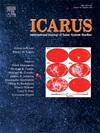地球和火星上多边形地面的形态计量学:从轨道上评估形成机制
IF 2.5
2区 物理与天体物理
Q2 ASTRONOMY & ASTROPHYSICS
引用次数: 0
摘要
多边形地面图案是在地球、火星和其他行星上常见的米到十米尺度的地貌。它们可以通过各种过程(冰缘、干燥、火山、接合)形成,并提供对影响可居住性的地质和环境条件的见解。我们专注于这些模式的形态计量学分析,以确定诊断特征,这些特征可用于远程区分不同的形成机制,特别是在没有现场观察的情况下。我们对17个地球地点和12个火星地点的图案地面进行了调查,以确定直径分布、结角、结价、圆度和纵横比,以确定每种多边形类型的特征。我们的结果显示,在相似的多边形类型中,形态特征的聚类是共同的,尽管在形成端元之间仍然存在一些模糊性。尺寸-频率分布和90°与120°结角的比值是形成过程的有力指标。结角比还揭示了由于周期性或偶发性重复压裂造成的网络“成熟度”。结价、圆度和纵横比也被证明是有价值的统计指标。我们分析了位于Jezero陨石坑底部和边缘单元的多边形图案,以及位于Terby陨石坑的两个地点,这些图案与火山和构造接合过程相一致。对Mawrth Vallis的分析强烈地暗示了干燥。这些发现表明,类似的物理机制控制着行星体上多边形的形成,对火星上这些模式的研究可以为其地质和气候历史提供关键见解,为潜在的可居住性提供线索。本文章由计算机程序翻译,如有差异,请以英文原文为准。
Morphometrics of polygonal ground on Earth and Mars: Assessing formation mechanisms from orbit
Polygonal ground patterns are meter-to-decameter-scale landforms commonly observed on Earth, Mars, and other planetary bodies. They can form through a variety of processes (periglacial, desiccation, volcanic, jointing) and provide insight into geological and environmental conditions that can influence habitability. We focus on the morphometric analysis of these patterns to determine diagnostic signatures which may be used to remotely distinguish between the different formation mechanisms, particularly when in-situ observations are not available. We conducted a survey of patterned ground at 17 Earth sites and 12 Mars sites to determine the diameter distributions, junction angles, junction valencies, circularities, and aspect ratios to determine the characteristics of each polygon type. Our results showed common clustering of morphometric characteristics amongst similar polygon types, though some ambiguities remain between formation endmembers. The size-frequency distributions and the ratio of 90° to 120° junction angles were strong indicators of formation process. The junction angle ratio also reveals the “maturity” of the networks due to periodic or episodic refracturing. Junction valency, circularity, and aspect ratios, also proved valuable as statistical indicators. Our analysis of polygonal patterns located in the Jezero crater floor and margin unit, along with two sites located at Terby crater, are consistent with both volcanic and tectonic jointing processes. Analysis of Mawrth Vallis is strongly suggestive of desiccation. These findings suggest that similar physical mechanisms control polygon formation across planetary bodies, and the study of these patterns on Mars can provide key insights into its geological and climate history, providing clues to potential habitability.
求助全文
通过发布文献求助,成功后即可免费获取论文全文。
去求助
来源期刊

Icarus
地学天文-天文与天体物理
CiteScore
6.30
自引率
18.80%
发文量
356
审稿时长
2-4 weeks
期刊介绍:
Icarus is devoted to the publication of original contributions in the field of Solar System studies. Manuscripts reporting the results of new research - observational, experimental, or theoretical - concerning the astronomy, geology, meteorology, physics, chemistry, biology, and other scientific aspects of our Solar System or extrasolar systems are welcome. The journal generally does not publish papers devoted exclusively to the Sun, the Earth, celestial mechanics, meteoritics, or astrophysics. Icarus does not publish papers that provide "improved" versions of Bode''s law, or other numerical relations, without a sound physical basis. Icarus does not publish meeting announcements or general notices. Reviews, historical papers, and manuscripts describing spacecraft instrumentation may be considered, but only with prior approval of the editor. An entire issue of the journal is occasionally devoted to a single subject, usually arising from a conference on the same topic. The language of publication is English. American or British usage is accepted, but not a mixture of these.
 求助内容:
求助内容: 应助结果提醒方式:
应助结果提醒方式:


